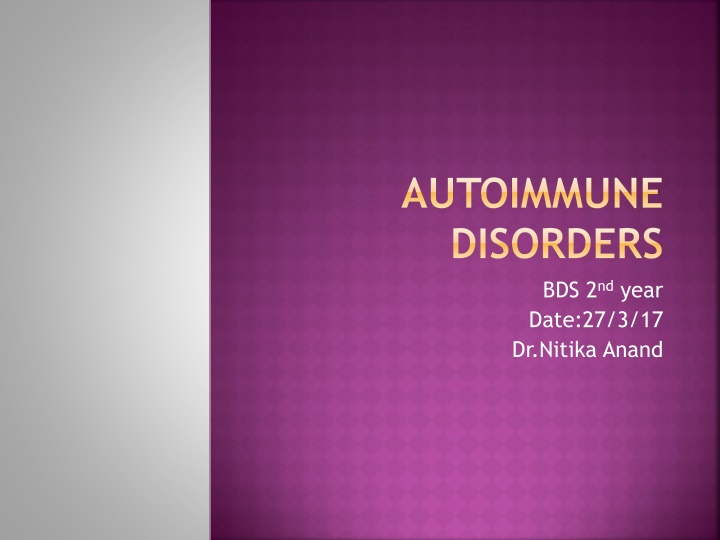
Autoimmune Disorders: Mechanisms, Tolerance, and Implications
Explore the intricacies of autoimmune disorders, including the immune response against self-antigens, mechanisms of autoimmunity, and breakdown of immunological homeostasis. Learn about immunological tolerance, types of tolerance, and hidden antigens that can trigger immune reactions. Dive into the complexities of autoimmunity and its impact on the body's tissues and functions.
Download Presentation

Please find below an Image/Link to download the presentation.
The content on the website is provided AS IS for your information and personal use only. It may not be sold, licensed, or shared on other websites without obtaining consent from the author. If you encounter any issues during the download, it is possible that the publisher has removed the file from their server.
You are allowed to download the files provided on this website for personal or commercial use, subject to the condition that they are used lawfully. All files are the property of their respective owners.
The content on the website is provided AS IS for your information and personal use only. It may not be sold, licensed, or shared on other websites without obtaining consent from the author.
E N D
Presentation Transcript
AUTOIMMUNE DISORDERS BDS 2ndyear Date:27/3/17 Dr.Nitika Anand
Autoimmunity is a condition in which body produces autoantibodies & immunocompetent cells against the normal components of the body. Referred to as Injury to self . Autoimmunity leads to structural or functional damage to tissues.
IMMUNOLOGICAL TOLERANCE This is condition in which contact with antigen specifically abolish mounting of Immune response against it when it is administered subsequently.
TYPES OF IMMUNOLOGICAL TOLERANCE a)Tolerance to Self antigen: Normally body do not mount immune response against self antigen known as Self tolerance. When immune response is mounted against Self antigen,autoimmune disease develop. b) Tolerance to non self antigen: A condition where a non self antigen induces a state of unresponsiveness to itself.
MECHANISMS OF AUTOIMMUNITY 1)Hidden or sequestered Antigens: Certain antigens are present in closed system & are not accessible to immune apparatus.Therefore,they not recognised as Self Ag. When these antigens are released into circulation due to trauma etc,they invoke immune response. Eg: -eye lens protein enclosed in its capsule. -sperm antigens that develop during puberty .
2)Antigen alteration: Cells or tissues may undergo antigenic alteration as a result of Physical(irradiation), chemical(drugs) or biological effects (viruses, bacterial enzymes). Such altered neoantigens may elicit immune response.
3)Breakdown of immunological homeostasis During embryonic life, clones of cells having immunological reactivity with self antigens are eliminated. Such clones are called forbidden clones. Their persistence or development in later life due to mutation can lead to autoimmunity.
4)Cross reacting Foreign antigens(Molecular mimicry): Sharing of antigens by different organisms is the basis of cross reacting antigen theory of autoimmunity. Eg Streptococcus M protein & heart muscle share antigenic similarity. Immune response induced by repeated Streptococcal infection can damage the heart.
CCLASSIFICATION OF AUTOIMMUNE DISORDERS
AUTOIMMUNE DISORDERS OF ORAL CAVITY
ORAL LICHEN PLANUS Common mucocutaneous disease. Condition can affect either skin,mucosa or both. It affects adults older than 40 yrs although younger adults , children can be affected. Etiology: It is T cell mediated autoimmune Disease in which CD8 T cells triggers apoptosis of oral epithelial cells
ORAL MANIFESTATIONS: It presents as bilateral white striations, papules or plaques on buccal mucosa , Tongue,gingivae. Lesions on buccal mucosa accompanies or precedes the appearance of lesions on skin & genital mucous membrane
PEMPHIGOUS VULGARIS This is an autoimmune , intraepithelial blistering disease affecting skin & mucous membrane. Etiology: Disease is triggered by autoantibodies against keratinocyte cell surface.
ORAL MANIFESTATIONS It presents as ill defined, irregularly shaped erosions on gingiva , buccal mucosa that are painful & slow in healing. Mucosal lesions may precede cutaneous lesions by months.
Pemphigous vulgaris frequently affects inner lining of mouth. In this image, there is loss of top layer of skin of the lip.
ERYTHEMA MULTIFORME This is an acute self limiting dermatitis. EM minor represents localized eruption of skin with mild mucosal involvement. EM major & Stevens johnson syndrome(SJS) represents severe & life threatning mucosal & skin disease.
Etiology: Certain drugs & infectious agents can cause EM. EM minor is triggered by HSV , Mycoplasma infection. Sulfa drugs are common triggers. Oral manifestations: Oral lesions in EM include macules,papule or vesicles on tongue,palate, buccal mucosa, gingiva that are painful.
In SJS ,oral lesions are severe & painful that even mastication become impossible.Painful vesicles appear on mucosa, lips and become ulcerated with bloody crusting. Disease resembles acute necrotising ulcerative gingivostomatitis.
